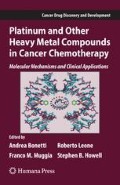Abstract
Our studies of half-sandwich osmium(II) arene complexes of the type [(η6-arene)Os(XY)Z] show that hydrolysis of the Os–Z (Z = Cl) bond and degree of formation of biologically inactive hydroxo-bridged dimers can be controlled by the choice of the chelated ligand XY. The chemistry and cancer-cell cytotoxicity of complexes containing N,N-, N,O-, or O,O-chelating ligands are compared and contrasted. The wide kinetic timescales of the reactions of these osmium complexes are notable and promising for the design of novel anti-cancer agents.
Access this chapter
Tax calculation will be finalised at checkout
Purchases are for personal use only
References
Rademaker-Lakhai JM, Van Den Bongard D, Pluim D, Beijnen JH, Schellens JHM. A phase I and pharmacological study with imidazolium-trans-DMSO-imidazole-tetrachlororuthenate, a novel ruthenium anticancer agent. Clin Cancer Res 2004;10:3717–27.
Jakupec MA, Arion VB, Kapitza S, et al. KP1019 (FFC14A) from bench to bedside: preclinical and early clinical development — an overview. Int J Clin Pharmacol Ther 2005;43:595–6.
Yan YK, Melchart M, Habtemariam A, Sadler PJ. Organometallic chemistry, biology and medicine: ruthenium arene anticancer complexes. Chem Commun 2005;(38):4764–76.
Aird RE, Cummings J, Ritchie AA, et al. In vitro and in vivo activity and cross resistance profiles of novel ruthenium (II) organometallic arene complexes in human ovarian cancer. Br J Cancer 2002;86:1652–7.
Peacock AFA, Habtemariam A, Fernandez R, et al. Tuning the reactivity of osmium(II) and ruthenium(II) arene complexes under physiological conditions. J Am Chem Soc 2006; 128:1739–48.
Peacock AFA, Habtemariam A, Moggach SA, Prescimone A, Parsons S, Sadler PJ. Chloro half-sandwich osmium(II) complexes: influence of chelated N,N-ligands on hydrolysis, guanine binding, and cytotoxicity. Inorg. Chem. 2007;46:4049–59.
Schmid WF, John RO, Arion VB, Jakupec MA, Keppler BK. Highly antiproliferative ruthenium(II) and osmium(II) arene complexes with paullone-derived ligands. Organometallics 2007;26:6643–52.
Peacock AFA, Melchart M, Deeth RJ, Habtemariam A, Parsons S, Sadler PJ. Osmium(II) and ruthenium(II) arene maltolato complexes: Rapid hydrolysis and nucleobase binding. Chem Eur J 2007;13:2601–13.
Peacock AFA, Parsons S, Sadler PJ. Tuning the hydrolytic aqueous chemistry of osmium arene complexes with N,O-chelating ligands to achieve cancer cell cytotoxicity. J Am Chem Soc 2007;129:3348–57.
Dorcier A, Ang WH, Bolano S, et al. In vitro evaluation of rhodium and osmium RAPTA analogues: the case for organometallic anticancer drugs not based on ruthenium. Organometallics 2006;25:4090–6.
Dorcier A, Dyson PJ, Gossens C, Rothlisberger U, Scopelliti R, Tavernelli I. Binding of organometallic ruthenium(II) and osmium(II) complexes to an oligonucleotide: a combined mass spectrometric and theoretical study. Organometallics 2005;24:2114–23.
Wang F, Chen HM, Parsons S, Oswald LDH, Davidson JE, Sadler PJ. Kinetics of aquation and anation of ruthenium(II) arene anticancer complexes, acidity and X-ray structures of aqua adducts. Chem Eur J 2003;9:5810–20.
Zhang CX, Lippard SJ. New metal complexes as potential therapeutics. Curr Opin Chem Biol 2003;7:481–9.
Brabec V, Novakova O. DNA binding mode of ruthenium complexes and relationship to tumor cell toxicity. Drug Resist Update 2006;9:111–22.
Fernandez R, Melchart M, Habtemariam A, Parsons S, Sadler PL. Use of chelating ligands to tune the reactive site of half-sandwich ruthenium(II)-arene anticancer complexes. Chem Eur J 2004;10:5173–9.
Kostrhunova H, Florian J, Novakova O, Peacock AFA, Sadler PJ, Brabec V. DNA interactions of monofunctional organometallic osmium(II) anti-tumor complexes in cell-free media. J. Med. Chem. 2008;51:3635–43.
Author information
Authors and Affiliations
Editor information
Editors and Affiliations
Rights and permissions
Copyright information
© 2009 Springer Science+Business Media, LLC
About this chapter
Cite this chapter
Rijt, S.H., Peacock, A.F.A., Sadler, P.J. (2009). Osmium Arenes: A New Class of Potential Anti-cancer Agents. In: Bonetti, A., Leone, R., Muggia, F.M., Howell, S.B. (eds) Platinum and Other Heavy Metal Compounds in Cancer Chemotherapy. Cancer Drug Discovery and Development. Humana Press, Totowa, NJ. https://doi.org/10.1007/978-1-60327-459-3_10
Download citation
DOI: https://doi.org/10.1007/978-1-60327-459-3_10
Publisher Name: Humana Press, Totowa, NJ
Print ISBN: 978-1-60327-458-6
Online ISBN: 978-1-60327-459-3
eBook Packages: Biomedical and Life SciencesBiomedical and Life Sciences (R0)

